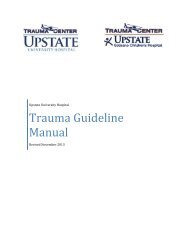10 Alumni Journal - SUNY Upstate Medical University
10 Alumni Journal - SUNY Upstate Medical University
10 Alumni Journal - SUNY Upstate Medical University
Create successful ePaper yourself
Turn your PDF publications into a flip-book with our unique Google optimized e-Paper software.
StAtE Of tHE ARt<br />
Six years ago, the anatomy lab underwent a<br />
major renovation, updating the space built<br />
in 1953 into a modern state-of-the-art classroom<br />
for learning about the human body.<br />
Although essentially one large room, the<br />
space is organized into five teaching modules,<br />
four containing six dissecting stations<br />
and the fifth used for demonstrations and<br />
presentations to small groups of students.<br />
The video equipment effectively brings all<br />
those spaces together into one. It began as a<br />
gift from Hansen Yuan, HS ’74, former chair<br />
of the <strong>Upstate</strong> Department of Orthopedics<br />
in the name of his son and daughter-in-law,<br />
David Yuan, MD ’99, and Ellen Young,<br />
MD ’99. Dr. Yuan provided funds for the<br />
high-definition digital camera, the only one<br />
on the <strong>Upstate</strong> campus, and the Department<br />
of Cell and Developmental Biology followed<br />
with the purchase of six large flat-screen<br />
monitors, allowing instructors to teach a<br />
particular dissecting procedure to a large<br />
group at once.<br />
The technology has not only expedited<br />
the process but improved the ability to learn<br />
from the dissection.<br />
Once a year, Berg brings in two orthopedic<br />
surgeons who do hip and knee replacement<br />
on an unfixed cadaver. Previously—in<br />
order for all students to see—the procedures<br />
had to be conducted in the ninth-floor<br />
auditorium, which created issues with<br />
body fluids and sterility. Now, the procedures<br />
can be done in the anatomy<br />
lab, allowing students closer access<br />
and the opportunity to interact with<br />
the surgeons.<br />
And it’s not just gross anatomy<br />
students who are benefiting. Students<br />
in the doctorate of physical therapy<br />
and physician’s assistant programs have<br />
summer programs in the anatomy lab.<br />
“The technology allows the instructor<br />
to assist a maximum amount of students at<br />
one time,” says physical therapy graduate<br />
student Maggie Reinhard, who has both<br />
taken anatomy and assisted Berg in teaching.<br />
“When working on dissections in small<br />
groups of five or six, it is incredibly difficult<br />
for the primary instructor and one teaching<br />
assistant to be present and helpful to all the<br />
groups. The use of the technology allows for<br />
the instructor to point out things and teach<br />
the whole class and ensure that everyone<br />
in the class is able to view the dissection.”<br />
It’s also altered the way courses are<br />
taught. “In anatomy, many of the lectures are<br />
purely descriptive (the anatomy of the arm<br />
or leg, for example). This can now be done<br />
in the lab using the video system allowing<br />
lecture time to be used for case studies or<br />
problem-solving activities,” says Reinhard.<br />
Clinical departments—such as orthopedics,<br />
anesthesia, and emergency medicine—<br />
are making use of that same advantage.<br />
“We’ve got clinical departments who now<br />
combine the didactic portion of a lesson with<br />
the lab portion by hooking up a laptop and<br />
showing a PowerPoint presentation on the<br />
screens instead of having to do that across<br />
the hall first,” says Dr. Sanger.<br />
<strong>Upstate</strong>’s facilities are ahead of the curve.<br />
Recently, a contingent from the<br />
A l U M n i J o U r n A l / s P r i n g 2 0 1 0 13<br />
<strong>University</strong> of Rochester paid a visit to get<br />
ideas for their own upcoming lab renovation.<br />
And Berg believes they have only<br />
scratched the surface on how the technology<br />
might be used. “My goal is to make the lab<br />
experience increasingly interactive, so students<br />
not only know how to find structures<br />
but know how to use that information in the<br />
real world,” he says. He envisions projecting<br />
live demonstrations from the anatomy lab<br />
to even larger groups in the ninth-floor<br />
auditorium, and using the technology to<br />
combine the teaching of gross anatomy and<br />
anatomic pathology as future possibilities.<br />
“The dissection laboratory is the most<br />
unique experience medical students are going<br />
to have in at least their first two years,” says<br />
Berg. “We want to maximize the experience<br />
for them and this technology gives us that<br />
capability.” n

















